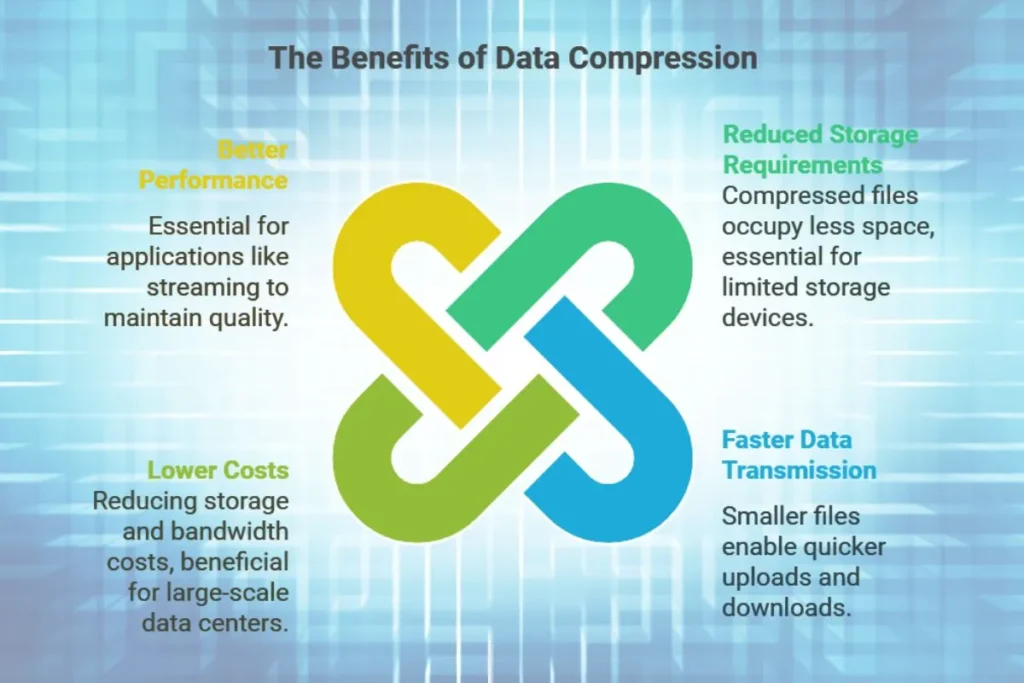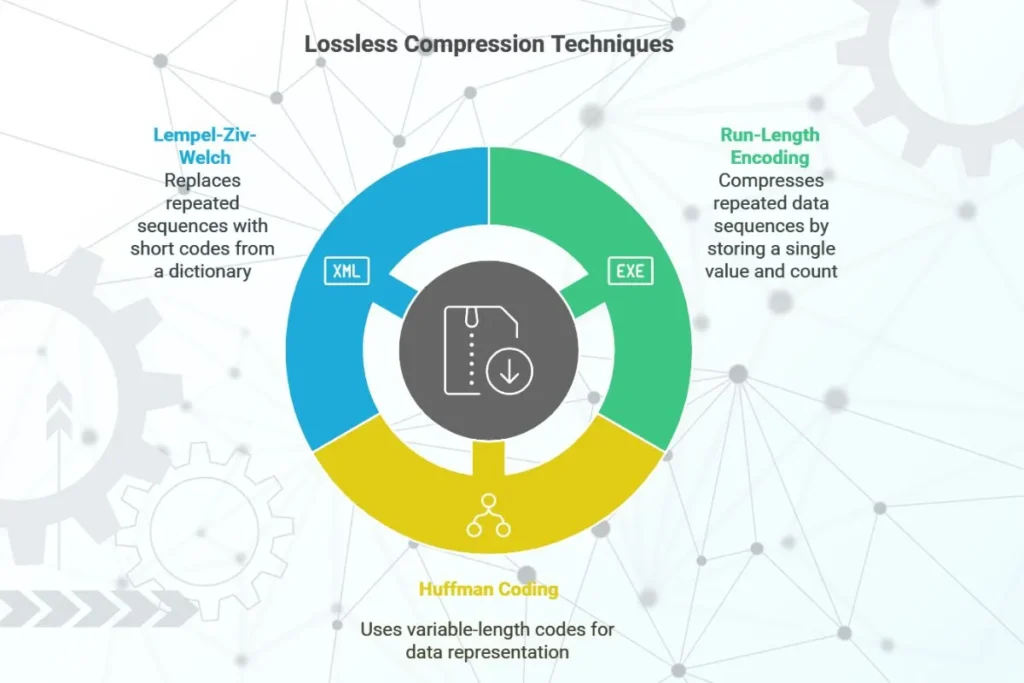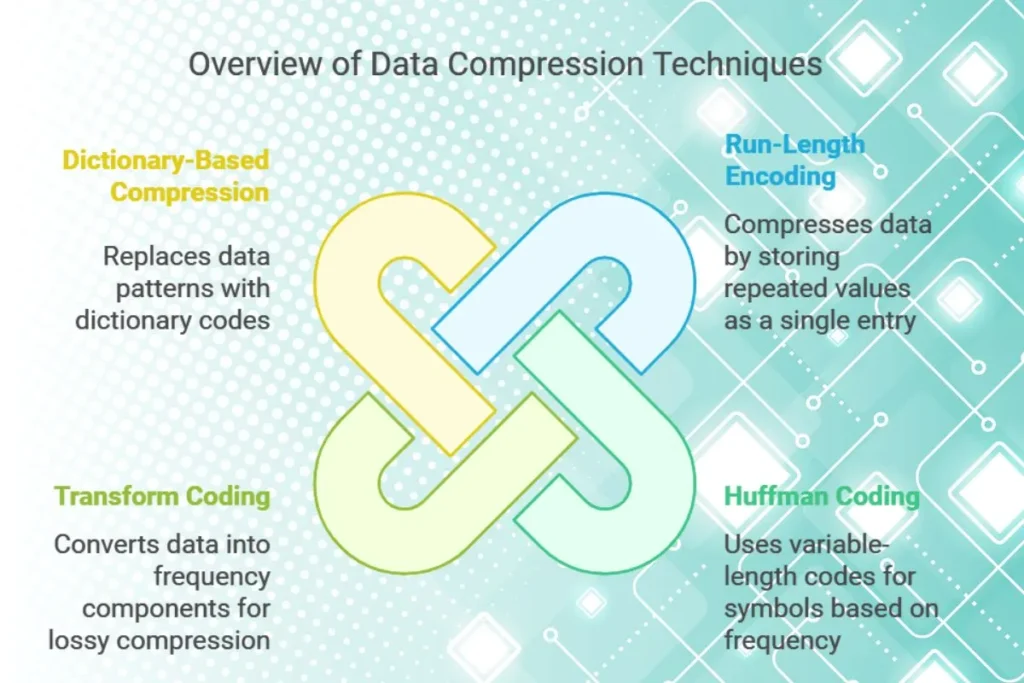Efficient data storage and data transfer are very important and essential in our day-to-days life. Whether streaming videos, saving images or sending files over the internet, data compression plays a very important role in making it all faster and more manageable. But how does data compression work and why is it so essential?
In this guide, we shall break down the basics of data compression, explore the differences between lossless and lossy compression, discuss common techniques. Also we shall discuss how compression algorithms are applied across various fields like image, audio and video processing.
What is Data Compression?
Data compression is the process of encoding information using fewer bits than the original representation. It reduces the size of data files to save storage space or decrease the time needed to transmit them. Compression allows for more efficient use of resources while maintaining a manageable level of quality for the data.
Compression is everywhere: from photos on social media and video streaming to music downloads and even website files. By reducing file sizes, data compression enhances performance and optimizes storage, which makes it essential for a range of applications.
Why is Data Compression Important?
Data compression offers several important benefits:
1. Reduced Storage Requirements: Compressed files take up less space, which is important for devices with limited storage or cloud environments where storage costs are high.
2. Faster Data Transmission: Smaller files upload and download faster, which reduces bandwidth usage, makes data transmission quicker and provides a better user experience.
3. Lower Costs: By compressing data, organizations can reduce storage and bandwidth costs, which is especially beneficial in large scale data centers.
4. Better Performance: Applications that handle multimedia files (such as streaming services) rely on compression to provide fast, efficient service without sacrificing quality.

Types of Data Compression: Lossless vs. Lossy
Data compression is generally classified into two main types: lossless and lossy. Each type serves different needs, depending on whether preserving original data is essential or if minor data loss is acceptable for greater compression.
1. Lossless Compression
Lossless compression is a method that reduces file size without losing any information. When a file is decompressed, it is restored to its original form, which makes it ideal for applications where data integrity is crucial (e.g., text documents, spreadsheets, software files).
Common techniques for lossless compression include:
Compresses repeated sequences of data by storing them as a single value and count.
Uses variable length codes to represent data, with more common elements receiving shorter codes.
Builds a dictionary of sequences and replaces repeated sequences with short codes.
Use cases: Lossless compression is often used for ZIP files, RAR files, PNG images and data backups where fidelity to the original data is required.
Example: When saving a text file with lossless compression, the content remains the same after decompression, which ensures the original document is preserved exactly as it was.

2. Lossy Compression
Lossy compression reduces file size by removing some data, typically data that is less noticeable or deemed less essential for human perception. This technique achieves higher compression ratios than lossless methods and makes it popular for media files.
Common techniques for lossy compression include:
– Transform Coding: Used in JPEG images and MP3 audio, this technique transforms data into a different domain, allowing for selective data loss.
– Quantization: In audio and video compression, quantization reduces precision in certain areas, which reduces the file size with minimal impact on perceived quality.
Use cases: Lossy compression is ideal for multimedia files, like JPEG images, MP3 audio and streaming videos, where some loss of detail is acceptable.
Example: When compressing a JPEG image, certain color details may be removed, slightly affecting quality. However, the image file size is significantly reduced, to allow for faster upload times and less storage use.

How Data Compression Works
Data compression involves various algorithms and techniques, each suited to specific file types and requirements. Below are some of the widely used compression methods:
1. Run-Length Encoding (RLE)
How it works: RLE compresses data by finding repeated sequences and storing them as a single value with a count. For example, the string “AAAAA” becomes “A5”.
Use cases: RLE is effective for files with long runs of repeated values, such as simple images or text files.
Example: In a black-and-white bitmap image, long stretches of black or white pixels are stored as a single entry (e.g., “20B” for 20 black pixels).
2. Huffman Coding
How it works: This technique uses variable-length codes for different symbols, with more common symbols assigned shorter codes, thereby reducing the total bit count.
Use cases: Huffman coding is used in lossless data compression for formats like PNG images and ZIP files.
Example: In text compression, letters like “E” that appear frequently are encoded with shorter bits than less common letters like “Z”.
3. Transform Coding (for Lossy Compression)
How it works: Used in lossy compression, transform coding (like Discrete Cosine Transform in JPEG) converts spatial data into frequency components, which allows data reduction by focusing only on visually significant parts.
Use cases: Commonly used in image and audio formats, such as JPEG and MP3.
Example: JPEG compression applies DCT to convert image data, to reduce color gradients that are less noticeable to the human eye to achieve smaller file sizes.
4. Dictionary Based Compression (LZW)
How it works: Dictionary-based compression algorithms, like LZW, replace repeated data patterns with short dictionary codes, to optimize space.
Use cases: This is used in GIFs, TIFFs and ZIP file formats.
Example: In a document where phrases repeat often, LZW assigns each phrase a code. The document is stored as codes, which are expanded back to phrases upon decompression.

Real-World Applications of Data Compression
1. Image Compression
Platforms like Instagram and Facebook use compression to optimize images for fast loading and minimal storage use without sacrificing user experience. JPEG (lossy) and PNG (lossless) formats are standard.
Case Study: Facebook employs both JPEG and WebP formats to reduce image size while preserving quality, which enables for faster loading times across devices and saving on storage costs.
2. Video Streaming
Streaming services like Netflix and YouTube rely heavily on compression algorithms, such as H.264 or H.265, to deliver high quality video with minimal data usage.
Case Study: Netflix uses adaptive bitrate streaming, adjusting video quality based on the user’s internet speed, for smooth streaming with optimal data usage.
3. File Sharing and Storage
Applications like Dropbox and Google Drive use compression to store data efficiently, which allows users to save more files with less storage.
Example: When uploading a file to Dropbox, the platform may compress the file for quicker upload and optimized storage.
Importance of Data Compression
Data compression’s importance has grown with the increasing demand for data storage, transmission and efficiency. Here we shall discuss why compression is important:
1. Efficient Resource Usage:
Compression reduces file sizes, which saves storage space and bandwidth.
2. Faster Access and Transfer:
Smaller file sizes mean quicker access and download times, which is essential for applications like video streaming.
3. Cost-Effectiveness:
Compression lowers storage and bandwidth costs, which benefits businesses to manage large data volumes.
4. Enhanced User Experience:
For websites and applications, data compression improves loading times, to give user smoother experience.
Conclusion:
Data compression is a powerful tool, which makes data handling and transmission faster and more cost effective without compromising on quality. By understanding the difference between lossless and lossy compression, the types of algorithms available and real world applications, you can appreciate how this technology shapes our digital experiences.
Data compression is an essential component of modern computing. As data volumes continue to rise, compression will remain a key solution for managing data efficiently and effectively.

